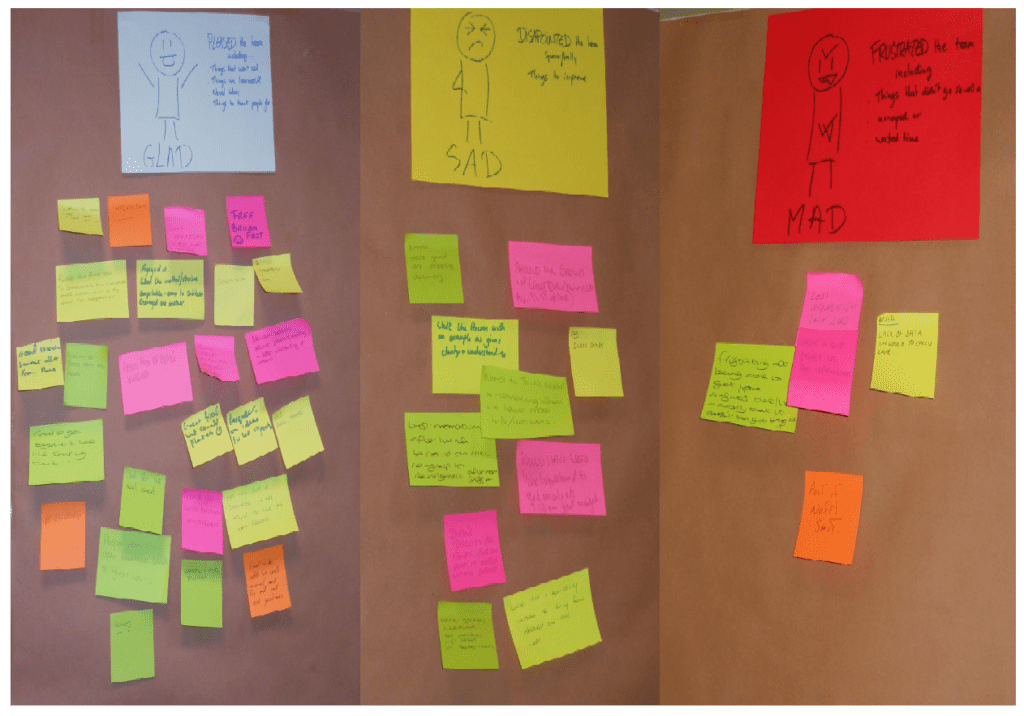You can find all our articles and past events
Free Articles | Inside PMO | PMO Conference | PMO Book Shelf
Two Learning Tools for the PMO to Use
Earlier this year we held our first session on “learning lessons from projects” in a PMO Mini-Masterclass held in Central London (you can take a look at the whole session here). The session looked at ways the PMO can get involved in that process we call “lessons learnt” (yet we all seem to dislike that phrase!).
A framework was introduced, some advice on facilitation and some different types of workshop tools or techniques that can be used.
That inspired one PMO Flashmobber – Jeremy Lesourd, Process Programme Manager from De La Rue – to put pen to paper and share a couple more tools which he uses in his work.
Here’s Jeremy with more insights:
I wanted to share a couple of tools that I use for learning following meetings, workshops and projects.
These are ‘Mad, Glad, Sad (the quick one…) and the ‘Feedback Value Tree’ (the long one!)
Mad Glad Sad
Mad Glad Sad comes from Agile and has been incorporated within the PRINCE2 Agile curriculum. Nothing new, just applying the known tool and adapted it a little. I use it mainly for meeting or workshops. It is quick, rather effective and works by ‘engaging with emotions’.
Mad – what FRUSTRATED the team including things that didn’t go so well, that people felt annoyed or wasted time.
Glad – what PLEASED the team including things that went well, that we learnt, novel ideas, things to thank people for.
Sad – what DISAPPOINTED the team including things to improve.
Following various tweaks I found that I got much more valuable content when leaving stickers with the 3 faces on the tables for people to write on and then to stick them anywhere on a brown paper on the wall. All anonymous and randomly placed. It gives straight away an idea of hired or fired!
At the end it looks something like this… 
Feedback Value Tree
For the Feedback Value Tree I have essentially turned the “user stories” from Agile into a feedback tool. I use it mainly for big projects.
So it looks like two types of stickers (again stickers!…) and brown paper again.
Type Smiley Face : As a <role> I liked <something> because <reason>.
Type Sad Face: As a <role> I would have liked <something> so that <benefit>
I put a large brown paper on a board on wheels and bring it to the project area/shop floor. I ask feedback from all stakeholders involved in the project (users, suppliers, customers, project team, site managers…). To ensure maximum capture I leave the board for up to 2 weeks.
The hard work comes next by cutting all the stickers!; affinitising them by reason/benefit; labelling the name of the categories and constructing a tree based on reason/benefit and underneath the liked/would have liked. I then take some branches and handover to the relevant work area to consider all the learning and how it could be incorporated within the area. I always make sure that we think of the good things too and how we ensure that the ‘liked’ are shared across various projects as well! We often miss them. 
At the end it looks something like this… (A couple of branches are only shown here)

*Prioritise the benefit using an AHP tool (Pairwise comparison tool) and feedback on satisfaction (Kano tool) then converting the scores into a value index inspired from Management of Value (MoV).
